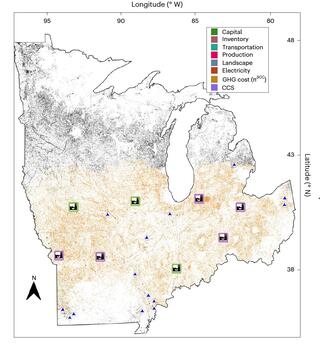Large-scale spatially explicit analysis of carbon capture at cellulosic biorefineries
E. O'Neill et al. "Large-scale spatially explicit analysis of carbon capture at cellulosic biorefineries" Nature Energy (2024) 9:828-838 [DOI:10.1038/s41560-024-01532-8]
The large-scale production of cellulosic biofuels would involve spatially distributed systems including biomass fields, logistics networks and biorefineries. Better understanding of the interactions between landscape-related decisions and the design of biorefineries with carbon capture and storage (CCS) in a supply chain context is needed to enable efficient systems. Here we analyse the cost and greenhouse gas mitigation potential for cellulosic biofuel supply chains in the US Midwest using realistic spatially explicit land availability and crop productivity data and consider fuel conversion technologies with detailed CCS design for their associated CO2 streams. Optimization methods identify trade-offs and design strategies leading to systems with attractive environmental and economic performance. Strategic and operational decisions depend on underlying spatial features and are sensitive to biofuel demand and CCS incentives. US CCS incentives neglect to motivate greenhouse gas mitigation from all supply chain emission sources, which leverage spatial interactions between CCS, electricity prices and the biomass landscape.
The data that support the findings of this study are available via Figshare at https://doi.org/10.6084/m9.figshare.24596394 (ref. 41). Included are values for all model parameters, geographic raw data for potential biomass yield, location and soil carbon sequestration and model output data.
